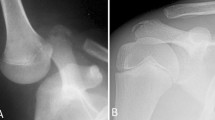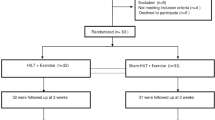Abstract
The aim of this investigation was to evaluate the long-term outcome of arthroscopic subacromial decompression (ASD) in patients with primary impingement syndrome stage II and early stage III. Ninety-five patients (105 shoulders, 48 female), mean age 54 years (range 26–69), who had undergone surgery between 1996 and 1999, were included. Pain intensity during activity and at rest, patient satisfaction, active range of motion (ROM), muscular strength and shoulder function using the Constant score were evaluated. Fifty-three (50%) shoulders were pain-free (Visual Analogue Scale ≤ 10 mm) during activity and 72 (68%) shoulders were pain-free at rest. Sixty-one (58%) patients stated that they were very satisfied and 27 (25%) were quite satisfied with regard to their current shoulder function. Shoulders were divided into Group 1: Pain-free patients (n = 53), Group 2: Patients with shoulder pain and no arthropathy (n = 41) and Group 3: Patients with shoulder pain and arthropathy (n = 11). The groups had average active ROM of 157°, 135° and 117°, respectively, in abduction and 97°, 79°, and 68° in external rotation. The average strength in elevation in the scapular plane was 7.4, 5.8 and 3.9 kg, respectively, whereas the mean value in external rotation was 8.4, 7.9 and 5.3 kg, respectively. The Constant score had a mean value of 87, 69 and 59 points in the three groups, respectively. Eleven shoulders have undergone re-operation, one after a new trauma. We conclude that ASD is a valuable procedure. Patients expressed a high degree of satisfaction with shoulder function 8–11 years after ASD.

Similar content being viewed by others
References
Anderson NH, Sojbjerg JO, Johannsen HV, Sneppen O (1999) Self-training versus physiotherapist-supervised rehabilitation of the shoulder in patients treated with arthroscopic subacromial decompression: a clinical randomized study. J Shoulder Elbow Surg 8:99–101
Bengtsson M, Lunsjo K, Hermodsson Y et al (2006) High patient satisfaction after arthroscopic subacromial decompression for shoulder impingement: a prospective study of 50 patients. Acta Orthop 77:138–142
Boone DC, Azen SP, Lin CM et al (1978) Reliability of goniometric measurements. Phys Ther 58:1355–1390
Brewster C, Schwab DR (1993) Rehabilitation of the shoulder following rotator cuff injury or surgery. J Orthop Sports Phys Ther 18:422–426
Brox JI, Gjengedal E, Uppheim G et al (1999) Arthroscopic surgery versus supervised exercises in patients with rotator cuff disease (stage II impingement syndrome): a prospective, randomized, controlled study in 125 patients with a 2 1/2-year follow-up. J Shoulder Elbow Surg 8:102–111
Budoff JE, Nirschl RP, Guidi EJ (1998) Debridement of partial-thickness tears of the rotator cuff without acromioplasty. Long-term follow-up and review of the literature. J Bone Joint Surg Am 80:733–748
Böhmer AS, Staff PH, Brox JI (1998) Supervised exercises in relation to rotator cuff disease (impingement syndrome stages II and III): a treatment regimen and its rationale. Physiother Theory Pract 14:93–105
Chipchase LS, O’Connor DA, Costi JJ, Krishnan J (2000) Shoulder impingement syndrome: preoperative health status. J Shoulder Elbow Surg 9:12–15
Constant CR, Murley AH (1987) A clinical method of functional assessment of the shoulder. Clin Orthop Relat Res 214:160–164
Croft PR, Macfarlane GJ, Papageorgiou AC et al (1998) Outcome of low back pain in general practice: a prospective study. BMJ 316:1356–1359
Dom K, Van Glabbeek F, Van Riet RP et al (2003) Arthroscopic subacromial decompression for advanced (stage II) impingement syndrome: a study of 52 patients with five years follow-up. Acta Orthop Belg 69:13–17
Edelson G, Teitz C (2000) Internal impingement in the shoulder. J Shoulder Elbow Surg 9:308–315
Gajdosik RL, Bohannon RW (1987) Clinical measurement of range of motion. Review of goniometry emphasizing reliability and validity. Phys Ther 67:1867–1872
Haahr JP, Ostergaard S, Dalsgaard J et al (2005) Exercises versus arthroscopic decompression in patients with subacromial impingement: a randomised, controlled study in 90 cases with a one year follow up. Ann Rheum Dis 64:760–764
Harryman DT, Sidles JA, Clark JM et al (1990) Translation of the humeral head on the glenoid with passive glenohumeral motion. J Bone Joint Surg Am 72:1334–1343
Hartsell HD, Forwell L (1997) Postoperative eccentric and concentric isokinetic strength for the shoulder rotators in the scapular and neutral planes. J Orthop Sports Phys Ther 25:19–25
Herberts P, Kadefors R, Andersson G, Petersen I (1981) Shoulder pain in industry: an epidemiological study on welders. Acta Orthop Scand 52:299–306
Jackins S (2004) Postoperative shoulder rehabilitation. Phys Med Rehabil Clin N Am 15:643–682
Jobe FW, Jobe CM (1983) Painful athletic injuries of the shoulder. Clin Orthop Relat Res 291:117–124
Jobe FW, Kvitne RS, Giangarra CE (1989) Shoulder pain in the overhand or throwing athlete. The relationship of anterior instability and rotator cuff impingement. Orthop Rev 18:963–975
Järvholm U, Palmerud G, Herberts P et al (1989) Intramuscular pressure and electromyography in the supraspinatus muscle at shoulder abduction. Clin Orthop Relat Res 245:102–109
Kamkar A, Irrgang JJ, Whitney SL (1993) Nonoperative management of secondary shoulder impingement syndrome. J Orthop Sports Phys Ther 17:212–224
Katolik LI, Romeo AA, Cole BJ et al (2005) Normalization of the Constant score. J Shoulder Elbow Surg 14:279–285
Kibler WB (1998) The role of the scapula in athletic shoulder function. Am J Sports Med 26:325–337
Leggin BG, Neuman RM, Iannotti JP et al (1996) Intrarater and interrater reliability of three isometric dynamometers in assessing shoulder strength. J Shoulder Elbow Surg 5:18–24
Lewis JS, Wright C, Green A (2005) Subacromial impingement syndrome: the effect of changing posture on shoulder range of movement. J Orthop Sports Phys Ther 35:72–87
Linsell L, Dawson J, Zondervan K et al (2006) Prevalence and incidence of adults consulting for shoulder conditions in UK primary care; patterns of diagnosis and referral. Rheumatology (Oxford) 45:215–221
Lippitt S, Matsen F (1993) Mechanisms of glenohumeral joint stability. Clin Orthop Relat Res 291:20–28
McCormack HM, Horne DJ, Sheather S (1988) Clinical applications of visual analogue scales: a critical review. Psychol Med 18:1007–1019
McIntosh L, McKenna K, Gustafsson L (2003) Active and passive shoulder range of motion in healthy older people. Br J Occup Ther 66:318–324
Meldrum D, Cahalane E, Conroy R et al (2007) Maximum voluntary isometric contraction: reference values and clinical application. Amyotroph Lateral Scler 8:47–55
Millett PJ, Wilcox RB III, O’Holleran JD, Warner JJ (2006) Rehabilitation of the rotator cuff: an evaluation-based approach. J Am Acad Orthop Surg 14:599–609
Neer CS II (1983) Impingement lesions. Clin Orthop Relat Res 54:70–77
Norlin R, Adolfsson L (2008) Small full-thickness tears do well ten to thirteen years after arthroscopic subacromial decompression. J Shoulder Elbow Surg 17:12S–16S
Nygren A, Berglund A, von Koch M (1995) Neck-and-shoulder pain, an increasing problem. Strategies for using insurance material to follow trends. Scand J Rehabil Med Suppl 32:107–112
Odenbring S, Wagner P, Atroshi I (2008) Long-term outcomes of arthroscopic acromioplasty for chronic shoulder impingement syndrome: a prospective cohort study with a minimum of 12 years’ follow-up. Arthroscopy 24:1092–1098
Paine RM, Voight M (1993) The role of the scapula. J Orthop Sports Phys Ther 18:386–391
Roddey TS, Cook KF, O’Malley KJ, Gartsman GM (2005) The relationship among strength and mobility measures and self-report outcome scores in persons after rotator cuff repair surgery: impairment measures are not enough. J Shoulder Elbow Surg 14:95S–98S
Roye RP, Grana WA, Yates CK (1995) Arthroscopic subacromial decompression: two- to seven-year follow-up. Arthroscopy 11:301–306
Townsend H, Jobe FW, Pink M, Perry J (1991) Electromyographic analysis of the glenohumeral muscles during a baseball rehabilitation program. Am J Sports Med 19:264–272
van der Windt DA, Koes BW, de Jong BA, Bouter LM (1995) Shoulder disorders in general practice: incidence, patient characteristics, and management. Ann Rheum Dis 54:959–964
Wang CH, McClure P, Pratt NE, Nobilini R (1999) Stretching and strengthening exercises: their effect on three-dimensional scapular kinematics. Arch Phys Med Rehabil 80:923–929
Warner JJ, Micheli LJ, Arslanian LE et al (1990) Patterns of flexibility, laxity, and strength in normal shoulders and shoulders with instability and impingement. Am J Sports Med 18:366–375
Warner JJ, Micheli LJ, Arslanian LE et al (1992) Scapulothoracic motion in normal shoulders and shoulders with glenohumeral instability and impingement syndrome. A study using Moire topographic analysis. Clin Orthop Relat Res 18:191–199
Wilk KE, Andrews JR (1993) Rehabilitation following arthroscopic subacromial decompression. Orthopedics 16:349–358
Wilk KE, Arrigo CA, Andrews JR (1991) Standardized isokinetic testing protocol for the throwing shoulder: the throwers’ series. Isokinet Exerc Sci 1:63–71
Acknowledgements
The authors would like to thank Gun-Brith Åsell, research assistant, for co-ordinating patient visits and administration and Valter Sund for statistical support. Financial support was provided by the Västra Götaland (research and education) research fund and the Centre for Sports Medicine Research. This study was approved by the Human Ethics Committee at the University of Gothenburg.
Author information
Authors and Affiliations
Corresponding author
Rights and permissions
About this article
Cite this article
Klintberg, I.H., Svantesson, U. & Karlsson, J. Long-term patient satisfaction and functional outcome 8–11 years after subacromial decompression. Knee Surg Sports Traumatol Arthrosc 18, 394–403 (2010). https://doi.org/10.1007/s00167-009-0963-1
Received:
Accepted:
Published:
Issue Date:
DOI: https://doi.org/10.1007/s00167-009-0963-1




